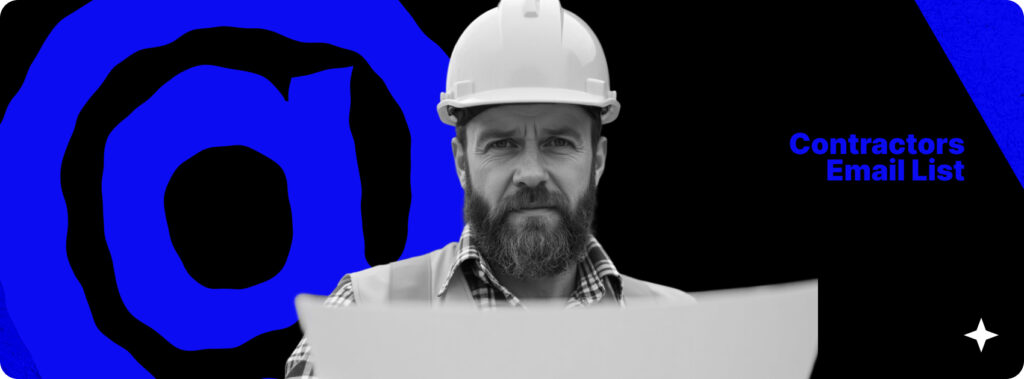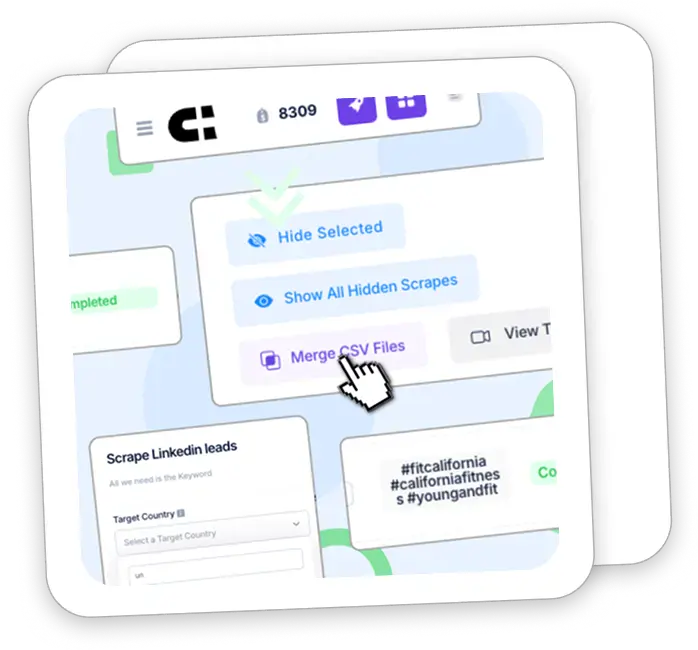Get Fresh Contractors Email List 2025

Contractors are the backbone of every project, and a targeted contractors email list is the fastest way to reach them. Instead of buying outdated databases, you can build your own with modern email scraping tools, pulling fresh contacts from LinkedIn, Google Maps, and business directories.
Top Ways to Get a Fresh Contractors Email List
If you’ve ever bought a contractors email list, you know the risks. High bounce rates, missing data, or emails that land in generic company inboxes. The best results come from building your own list, using reliable sources and filtering for exactly the type of contractors you want to reach.
Here are the top methods to source a clean, accurate contractors email list in 2025.
Use business directories and local listings
Platforms like Angi, Houzz, Yelp, and Google Maps list thousands of contractors with contact info, specialties, and service areas. These directories are great for finding professionals in specific trades or regions.
What to look for:
- Verified contractor profiles with email and website links
- Filters for trade (plumber, roofer, electrician, etc.) or location
- Exportable data or scraping-friendly layouts
Search LinkedIn by role and trade specialization
LinkedIn is surprisingly useful for targeting contractors, especially those in leadership roles at mid-sized construction firms. With tools like LinkedIn Sales Navigator, you can search by title, company size, and region.
How to search effectively:
- Use titles like General Contractor, Owner, Project Manager, or Subcontractor
- Filter by location and industry (construction, remodeling, home services)
- Save searches for automated alerts and list-building
Use scraping tools like IGLeads to automate list building
Scraping tools allow you to pull contact info from public sources without manually copying and pasting. With IGLeads, for example, you can target contractors by trade, location, and company size, then export a list ready for outreach.
IGLeads works well for:
- Targeting contractors in specific cities or states
- You Filtering by business category (e.g. HVAC, electrical, roofing)
- Getting a CSV file with names, emails, and company info
No coding needed. Just select your filters, run the scrape, and download your list.
Visit contractor websites and contact pages
Many contractors maintain websites with a contact page listing direct email addresses, names, and sometimes even cell phone numbers. This method is slower but useful for building highly targeted lists.
Best for:
- High-ticket or strategic outreach
- Verifying ownership or specialization
- Gathering context before sending a message
Manually collecting contact data works well when you’re focusing on a select group of firms.
Buy from vetted data providers — with caution
Some lead providers specialize in construction industry contacts. While this can save time, it’s essential to vet the source. Ask about how often the data is updated and whether it’s segmented by trade, location, or firm size.
What to check before buying:
- Last update date of the list
- Ability to filter by trade and region
- Deliverability rate and refund policy
- Compliance with data privacy laws
Use purchased lists as a starting point — not your entire strategy.
How to Use Your Contractors Email List Effectively
Having a contractors email list is a great start, but results only come when that list is paired with the right strategy. Contractors are busy, on-site, and often don’t have time for vague or salesy messages. To connect, you need short, clear outreach that respects their time and speaks directly to their needs.
Here’s how to turn your contractor contact list into real opportunities.
Break your list into targeted segments
Not all contractors offer the same services. A roofing contractor has very different needs than a general contractor or commercial builder. Segmenting your list lets you tailor your message and offer for each trade or region.
Examples:
- Electricians may need job scheduling software
- HVAC companies may respond to bulk equipment deals
- General contractors might be looking for subcontractors or finance partners
More specific segments mean more relevant messages and better response rates.
Keep your emails short and straight to the point
Contractors don’t read long emails. The best messages are brief, clear, and immediately show what’s in it for them. No fluff. No attachments. No guesswork.
Try this 4-line format:
- Line 1: Mention something relevant to their trade or location
- Line 2: Explain why you’re reaching out
- Line 3: Share one quick benefit (save time, lower cost, increase efficiency)
- Line 4: Add a simple CTA (quick call, reply, free trial, etc.)
Skip long intros or feature dumps. Focus on the outcome.
Use a multi-step follow-up sequence
Contractors are often away from their inbox. That’s why a single message isn’t enough. Follow up over a few days with reminders, useful resources, or a new angle.
Example 4-email sequence:
- Day 1: Short intro email
- Day 3: Follow-up with a quick case study or testimonial
- Day 6: Share a tool, guide, or comparison chart
- Day 9: Ask if someone else at the company is the right contact
Consistency without pressure builds familiarity and trust.
Offer value — not just a pitch
The fastest way to get a contractor to ignore you is to sound like a sales robot. Instead, lead with something useful. Help them solve a problem before asking for anything in return.
What to offer:
- Cost calculators or ROI templates
- Free tools for quotes, estimates, or scheduling
- Case studies showing real contractor success
- Safety checklists or industry benchmarks
Start with value. The pitch can come later.
Track what’s working and adjust your approach
Use email tracking tools to see which messages perform best. Watch your open rates, reply rates, and bounce rates to know where you’re losing people.
What to aim for:
- 35–50% open rate
- 10–15% reply rate (if well targeted)
- Bounce rate under 2%
A/B test your subject lines, call-to-actions, or follow-up spacing to improve over time.
Best Industries and Use Cases for Contractors Email Outreach
Contractors work across a wide range of industries — from small local projects to large commercial builds. Whether you’re selling physical products, digital tools, or professional services, a clean contractors email list lets you reach the right decision-makers in the construction ecosystem.
Here are some of the most effective industries and use cases for targeting contractors through email.
Construction and trade software companies
If you offer scheduling tools, estimating apps, safety compliance platforms, or CRMs for the trades, reaching contractors directly through email is one of the fastest ways to drive demos and signups.
What they respond to:
- Mobile-first tools for job sites
- Easy-to-use estimating and invoicing platforms
- Compliance and safety documentation software
Use case examples:
- Targeting general contractors with all-in-one project management tools
- Reaching electricians with quoting apps tailored for electrical jobs
- Promoting mobile punch-in apps to small contractor teams
Equipment and tool suppliers
Contractors rely on the right tools and machinery to get the job done. Whether you’re selling hand tools, rentals, or heavy machinery, email outreach can help you reach purchase decision-makers directly.
What they respond to:
- Bulk discounts or contractor pricing
- Lease or rental options for larger equipment
- New product announcements or seasonal offers
Use case examples:
- Emailing HVAC companies with spring maintenance equipment bundles
- Targeting roofing contractors with safety gear promotions
- Offering tool rental deals to remodelers in specific regions
Financial services and insurance
From equipment loans to general liability insurance, contractors need financial support to operate and grow. These are high-trust sales that often begin with a well-timed email.
What they respond to:
- Simple financing terms with fast approvals
- Industry-specific insurance coverage
- Cash flow tools and contractor credit lines
Use case examples:
- Reaching sole-proprietor contractors with small business insurance packages
- Offering invoice factoring to subcontractors
- Promoting equipment leasing to midsize firms
- B2B partnerships and lead generation services
Many local and regional contractors are looking for new clients. If you offer marketing, SEO, or lead generation services focused on trades, outreach to contractors can be highly profitable.
What they respond to:
- Pay-per-lead or referral models
- Local SEO optimization offers
- Done-for-you lead funnel setups
Use case examples:
- Reaching bathroom remodelers with lead generation services
- Helping general contractors build out Google Business profiles
- Promoting website packages for home service providers
Tips for Keeping Your Contractors Email List Clean and Updated
Contractors frequently change companies, launch new businesses, or shift their focus. If you’re not maintaining your list, your outreach efforts will slowly become less effective — and potentially more costly. Keeping your contractors email list accurate is essential for staying relevant and maximizing your email deliverability.
Here’s how to keep your data fresh and high-performing over time.
Run regular re-scrapes and updates
Use scraping tools like IGLeads to re-pull contact data every 30 to 90 days. This ensures your list reflects changes in roles, companies, and contact info — especially important in the fast-moving construction space.
Tips:
- Schedule re-scrapes quarterly or before new campaigns
- Focus updates on key regions, trades, or contractor segments
- Use past scrape filters for consistency
This keeps your outreach aligned with real-world business shifts.
Watch your bounce rate and sender reputation
If too many emails bounce, your email platform may lower your deliverability or even block future campaigns. Bounced emails are often a sign of outdated or mistyped data — don’t ignore them.
Best practices:
- Keep bounce rate under 2%
- Use verification tools before uploading lists
- Remove invalid addresses immediately
Healthy lists help your emails land in inboxes, not spam folders.
Remove inactive or unresponsive contacts
A valid email doesn’t always mean an engaged recipient. Over time, you’ll gather contacts who never open or reply. Removing these helps improve your overall performance metrics and deliverability.
When to remove:
- No engagement after 3–4 email sequences
- Failed re-engagement campaigns
- Contact is no longer in your target role or industry
Prune your list regularly to keep it lean and effective.
Track job changes and company updates
Many contractors start new businesses, move into different trades, or expand into new service areas. If you track these movements, you can reconnect with them in a new capacity.
How to stay updated:
- Follow contacts on LinkedIn
- Re-scrape regions for updated contractor data
- Use Google Alerts or tools like BuiltWith to monitor company changes
Job shifts are often new sales opportunities, not the end of the relationship.
Follow compliance rules at every step
Whether you’re emailing contractors in the U.S., Canada, Europe, or beyond, it’s your responsibility to follow data privacy laws. Always give contacts a way to opt out, and never email scraped data that’s marked private or behind a login.
Compliance checklist:
- Include an unsubscribe link in every email
- Maintain clean opt-out and suppression lists
- Document how and when each contact was sourced
- Avoid enrichment tools that rely on non-public data
Staying compliant protects your reputation and builds trust over time.
Real-World Examples of Successful Contractor Email Outreach
A well-targeted contractors email list can do more than just boost open rates — it can lead to real conversations, partnerships, and revenue. The key is clean data, clear value, and a message that speaks the contractor’s language.
Below are a few anonymized examples of how businesses have successfully used contractor email outreach to grow.
Tool supplier expanding into new regions
A supplier of power tools and construction gear used IGLeads to generate a list of 3,000 general contractors across the Midwest. They segmented by state and sent a three-email sequence offering limited-time bulk discounts.
Results:
- 41% open rate
- 220 replies
- 70 new accounts created in under 30 days
Why it worked:
- Geo-targeted list built with real-time scraping
- Message focused on contractor pricing and fast delivery
- Follow-ups included testimonials from other contractors
SaaS company selling scheduling software
A tech company offering job scheduling and dispatch software targeted independent HVAC and electrical contractors. Their outreach highlighted mobile usability and time savings.
Results:
- 48% open rate
- 160 demos booked
- 22% conversion to paid plans over 8 weeks
Why it worked:
- Clear ROI messaging focused on saving admin time
- Segmented by trade for message alignment
- No hard selling — demo-first approach
Insurance provider growing contractor affiliate network
An insurance platform specializing in contractor liability coverage used email to reach small business owners in roofing, plumbing, and electrical work. They offered a co-branded referral program with recurring commissions.
Results:
- 15% reply rate
- 120 affiliate signups
- 18 new policies written in the first 6 weeks
Why it worked:
- Personalized outreach with a low-barrier offer
- Targeted at independent contractors looking for extra revenue
- Built trust with clear compliance info
Local marketing agency offering SEO services
A regional digital agency built a list of 500 contractors in their state, focusing on small firms without websites or with poor online presence. They used a short sequence offering free audits and example rankings.
Results:
- 33% open rate
- 45 audit requests
- 12 new monthly clients signed in 60 days
Why it worked:
- Local targeting with a clear, immediate value offer
- Short, helpful emails with a soft CTA
- Follow-ups focused on education, not selling
What to Do Next With Your Contractors Email List
Building a clean contractors email list is only the start. What determines your results is how you use it — and how you keep it fresh. With IGLeads, you have control over targeting, re-scraping, and volume, but you still need a smart outreach plan.
Segment by trade, region, and company size
IGLeads lets you scrape by location and keywords, so you can build lists tailored to general contractors, electricians, or roofers in specific regions. Segmenting this way makes your messaging more relevant and improves response rates.
Keep emails short and value-driven
Even with a strong list, long pitches won’t work. Aim for under 100 words and focus on what matters to contractors: saving time, lowering costs, or winning more bids. IGLeads’ volume of contacts means you can test variations quickly and see what sticks.
Use outreach sequences instead of one-off blasts
Plan 3 to 5 emails over 7 to 10 days. Because IGLeads pulls fresh data, you can continuously feed new contacts into your sequences instead of exhausting one static list.
Track performance and adjust
Vendor lists may outperform on deliverability since they filter harder, but with IGLeads you make up for it through recency and scale. Run your leads through a verifier, monitor bounces, and tweak subject lines and CTAs.
Keep your list clean
This is where IGLeads shines. You can re-scrape every month or quarter, which ensures you catch job changes, new businesses, and updated contact details. Static databases can’t match that freshness.
Stay compliant
IGLeads only scrapes from public sources, giving you a transparent starting point. Still, compliance is your responsibility. Always honor unsubscribes, avoid private data, and include opt-out links in your emails.
Bottom line: IGLeads won’t promise perfect deliverability like filtered vendor lists, but it gives you something more powerful: control, freshness, and scale. For contractors, where jobs and companies change fast, that flexibility is what keeps your outreach relevant.
Build Your Contractors Email List the Smart Way
Ready to start reaching contractors directly? With IGLeads, you don’t need coding skills or complicated setups. Just set your filters, run a scrape, and export clean, accurate contacts in minutes.
Find more construction industry contacts
- Get Fresh Construction Email List 2025
- Email Extractor Ultimate Guide 2025
- Architect Email List - How to Get a List of Architects?
- How To Get Roofing Leads: Proven Strategies
- Free Contractor Leads | Grow Your Business
Explore more lead generation strategies and tools
- B2B Lead Generation Solutions – Guide for 2025
- How to Build a High-Quality B2B Email List for Outbound Marketing
- Buy Email Lists for Marketing in 2025: Complete Guide to Business Leads
- Why Scrape Google Maps? Use Cases for Sales, Marketing & SEO
- B2C Lead Generation: The 2025 Playbook
- 15 Best Lead Generation Companies for 2025
- Best B2B email list providers in 2025
- Top Lead Generation Agencies Compared (2025)
- 18 Best B2B Lead Generation softwares in 2025
- Lead Generation Guide: Strategies & Tools for 2025
Frequently Asked Questions
A contractors email list is a collection of contact emails for construction professionals, including general contractors, subcontractors, and trade specialists.
Use tools like IGLeads to scrape real-time data from LinkedIn, Google Maps, and business directories based on trade, location, and company size.
Yes, if data is publicly available and you comply with regulations like CAN-SPAM and GDPR. Always include an unsubscribe option.
Update your list every 30 to 90 days. Contractors often change roles, start new businesses, or update their contact details.
IGLeads, Apollo, LinkedIn Sales Navigator, and Google Maps scrapers are all effective for building targeted contractor contact lists.





